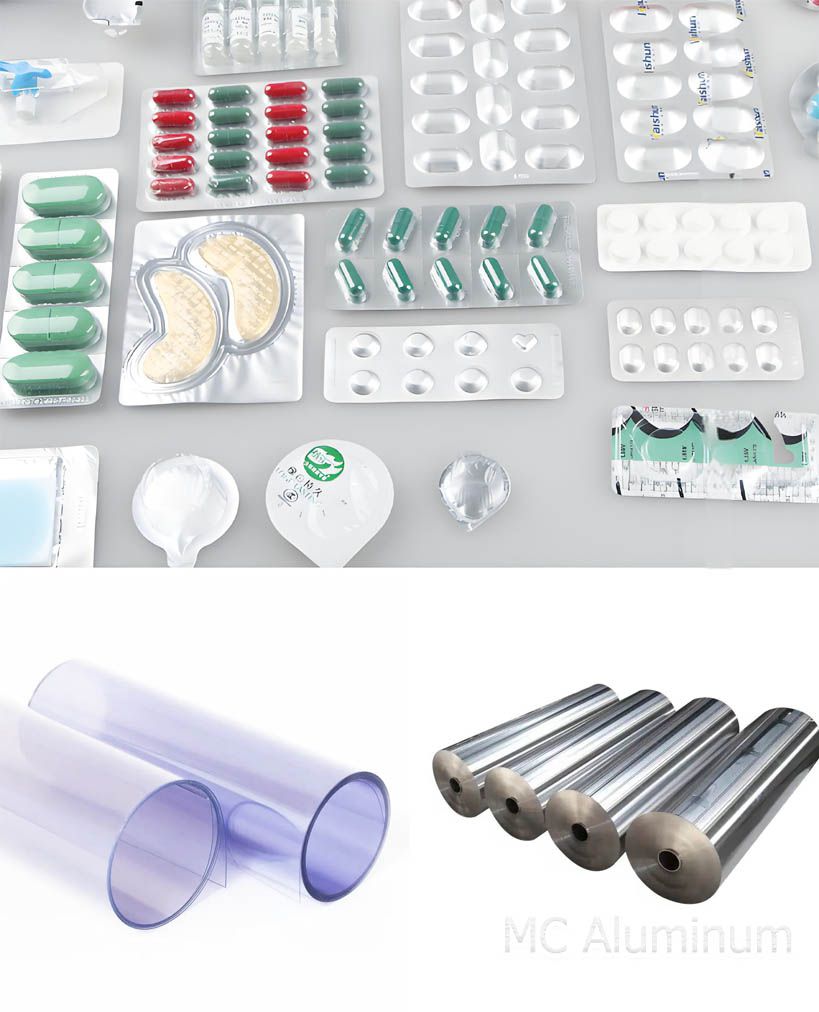What is blister packaging?
Blister packaging is a common form of packaging, mainly composed of a preformed cavity (blister) and a backing plate/liner, which plays a supporting and sealing role. Blisters are usually made of plastic and processed by thermoforming process, which can be customized according to product shape, quantity and size. It is usually used to package pills, tablets or capsules. Sometimes we also call it tablet blister packaging.

Six major materials for blister packaging in the pharmaceutical industry:
1.PVC
PVC (polyvinyl chloride) is a common material for blister packaging. It has good barrier properties and can effectively isolate moisture and prevent drugs from getting wet. In addition, it is easy to form and can be shaped into a variety of shapes to accommodate drugs of different dosage forms and sizes. At the same time, the cost is relatively low and economical.
However, PVC rigid films may interact with certain drug ingredients, affecting the stability and effectiveness of the drug. To improve its chemical stability and barrier properties, PVC is usually coated with PVDC (polyvinylidene chloride) or other high barrier materials to enhance moisture and oxidation resistance and ensure the safety of long-term storage of drugs.
2. PET
PET (polyester) is often used to make blisters and liners. It has high transparency, making the details of tablets or capsules clearly visible. At the same time, it is strong and durable, and can effectively protect drugs during transportation and storage. In addition, PET is recyclable and meets environmental protection requirements.
However, PET also has some limitations. It has low tolerance to certain chemicals and may react with certain drug ingredients, so it is not suitable for all types of drug packaging. In addition, compared with PVC, PET is more expensive, which may affect its widespread application.
3. PCTFE
PCTFE (polytrifluoroethylene) is a high-performance blister packaging material known for its excellent barrier properties and chemical stability. It can effectively prevent moisture and oxygen penetration, and is very suitable for protecting high-value drugs that are sensitive to moisture and oxidation. In addition, PCTFE has good transparency and mechanical strength, providing additional safety for drugs.
However, PCTFE is expensive and has complex processing, so it is mainly used for special purposes. For most pharmaceutical packaging, PVC, PVDC and other materials with lower prices and excellent performance are still the mainstream choice, which can reduce costs while meeting basic protection needs.
4. PS
PS (polystyrene) is often used as a backing material in pharmaceutical blister packaging to provide support and protection for drugs. It is easy to process and can adapt to a variety of packaging shapes. It is also low-cost and suitable for large-scale production.
However, PS has weak barrier properties and its protection against moisture and oxygen is not as good as other materials. In addition, it has poor heat resistance and is easily deformed in high temperature environments. Although PS has a high hardness, it is relatively brittle and fragile, so it needs to be combined with other materials in packaging design to enhance its performance.
5.PP & PE:
Polypropylene (PP) and polyethylene (PE) are widely used in pharmaceutical packaging, including blister packaging. They have good chemical stability and mechanical strength, and can effectively protect drugs from pollution and influence from the external environment.
6. Aluminum foil
Aluminum foil (8011 aluminum alloy) is a common liner material in aluminum-plastic blister packaging. It has excellent barrier properties and can effectively prevent moisture, oxygen and light from affecting drugs. In addition, it also has a tamper-proof seal to ensure that the tablets remain intact and stable during storage and use.
In order to improve safety, anti-counterfeiting marks, barcodes or QR codes are usually printed on aluminum foil to facilitate the authenticity verification of drugs and prevent counterfeit products from entering the market, thereby ensuring the safety of patients' medication.
MC Aluminum specializes in the production of pharmaceutical packaging materials, including aluminum foil, PVC rigid film, PVC/PVDC composite sheet, PCTFE, tropical blister aluminum, cold stamping aluminum, double aluminum easy-tear film and other products, which are widely used for packaging pills, granules, oral liquids, suppositories, etc. The product quality is stable, exported overseas, factory direct sales, preferential prices, free samples, welcome new and old customers to visit the factory.
